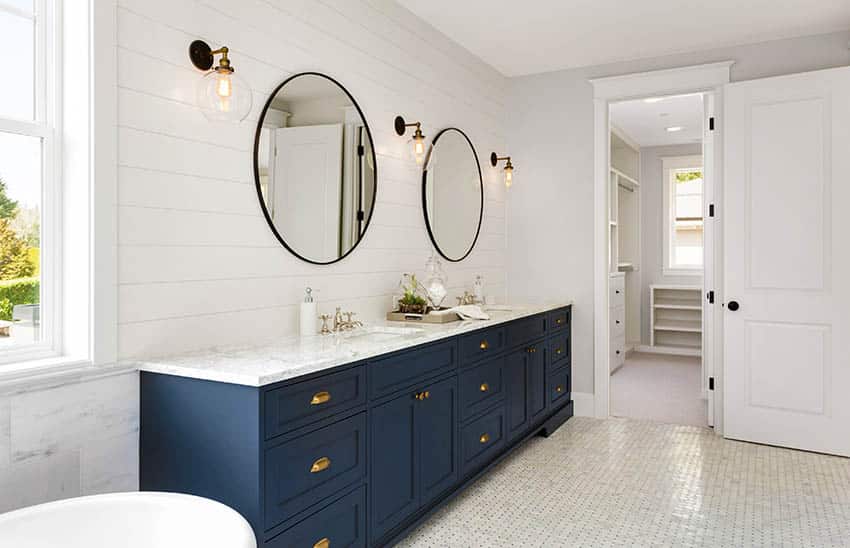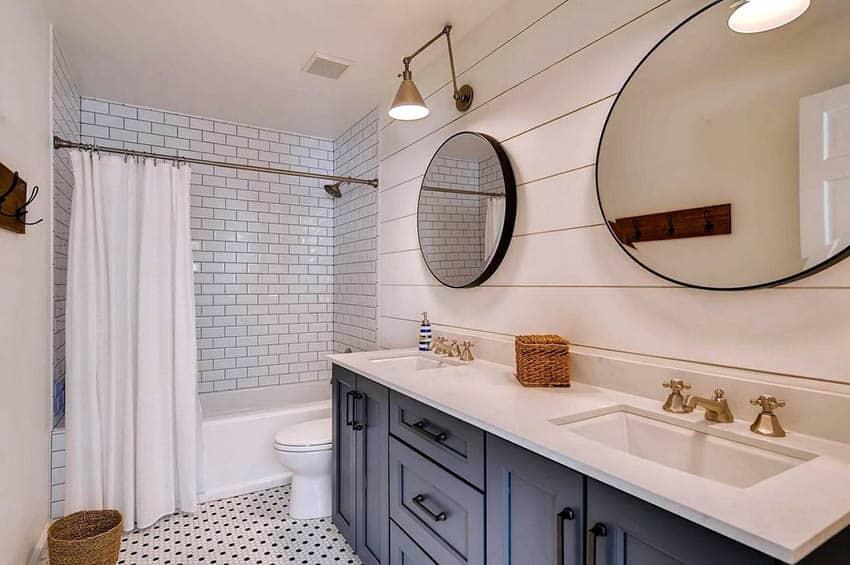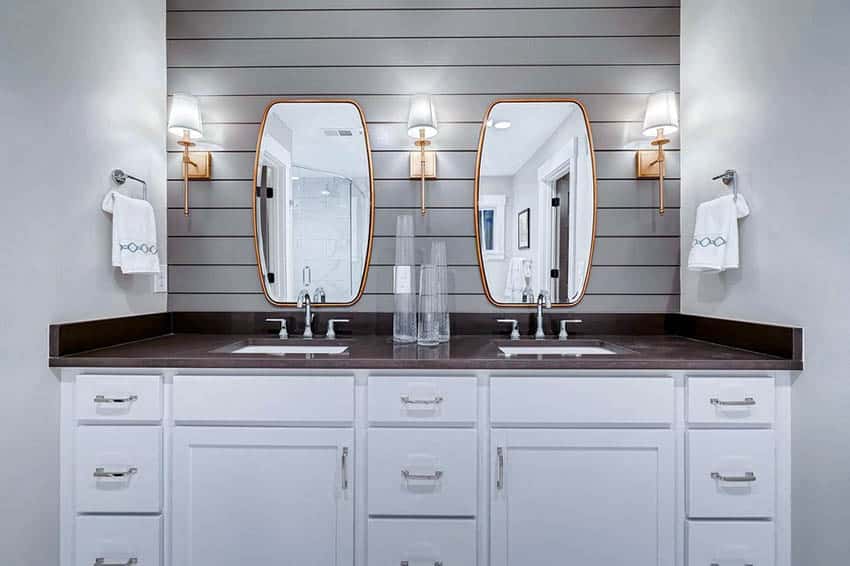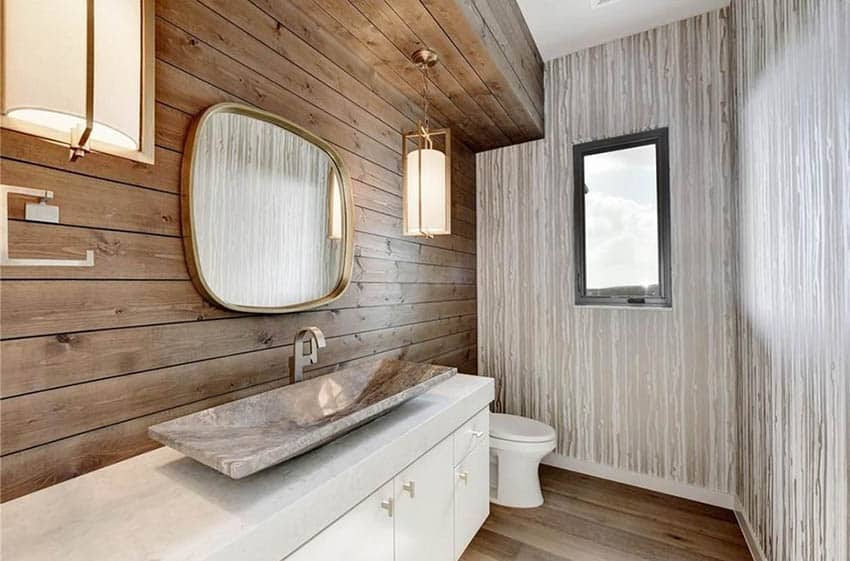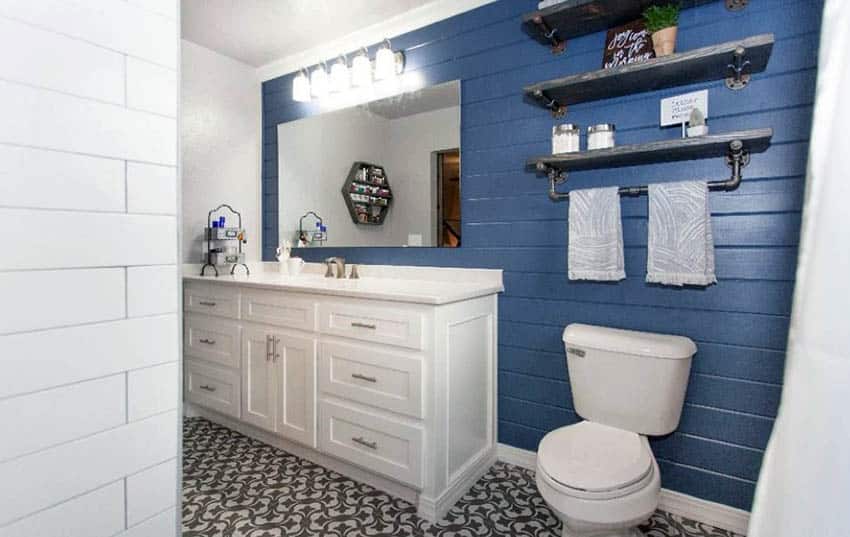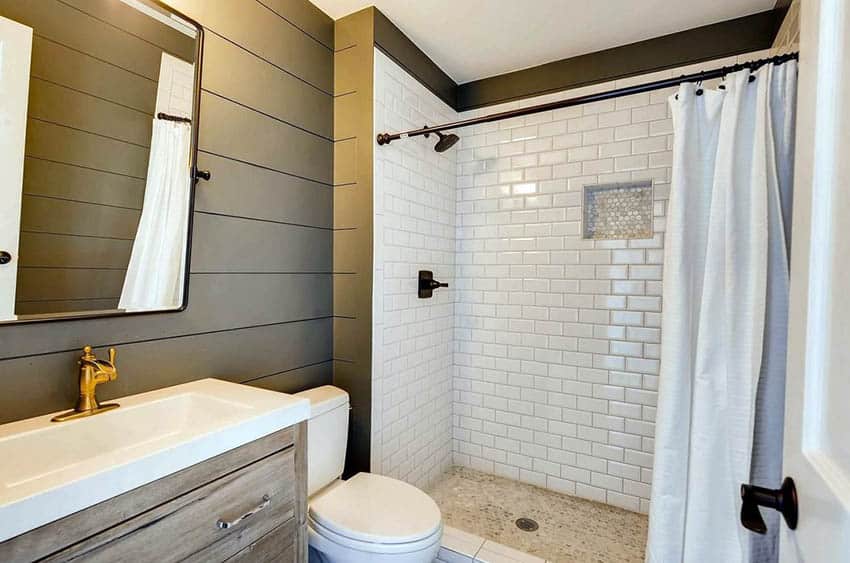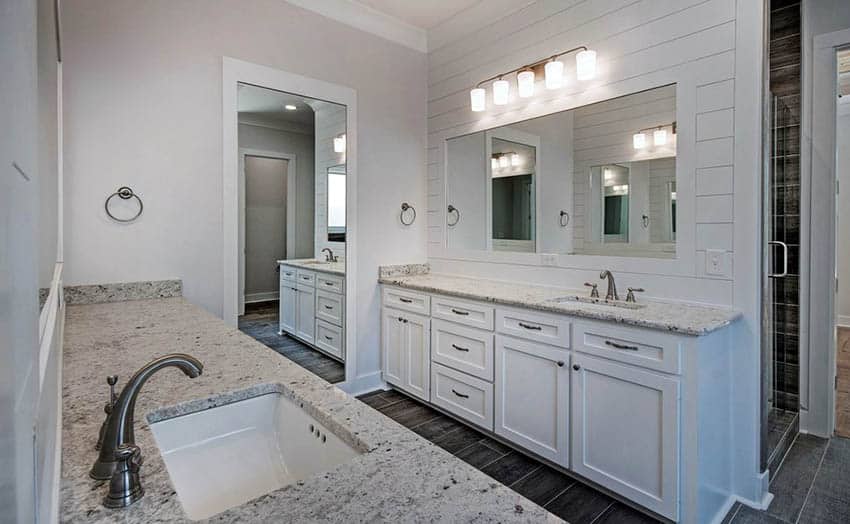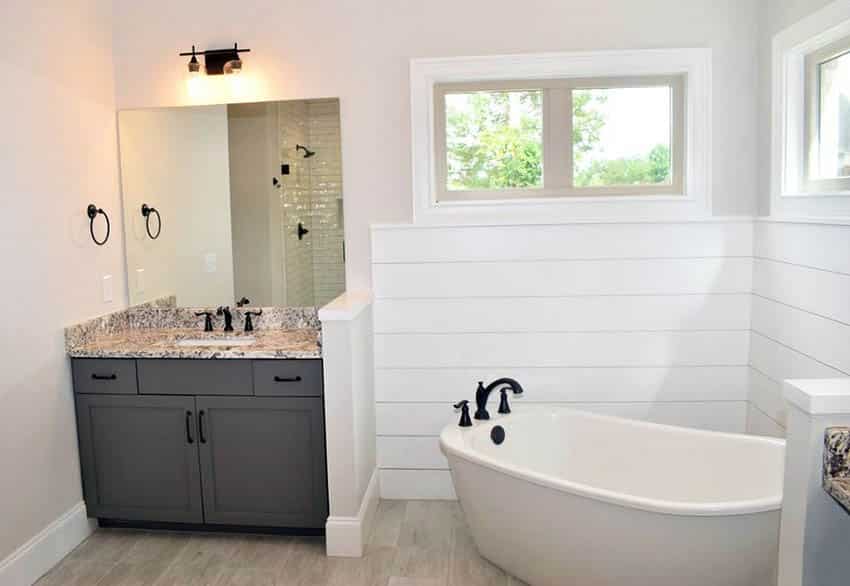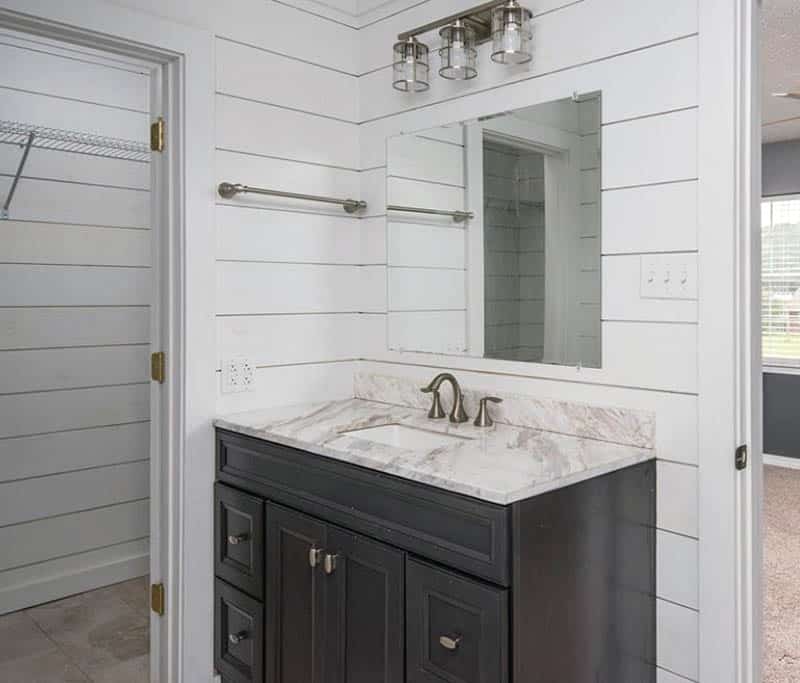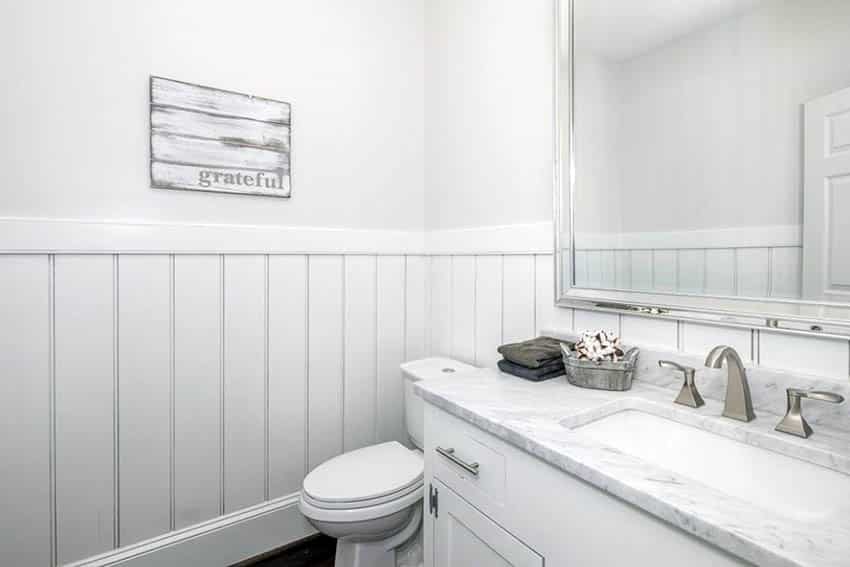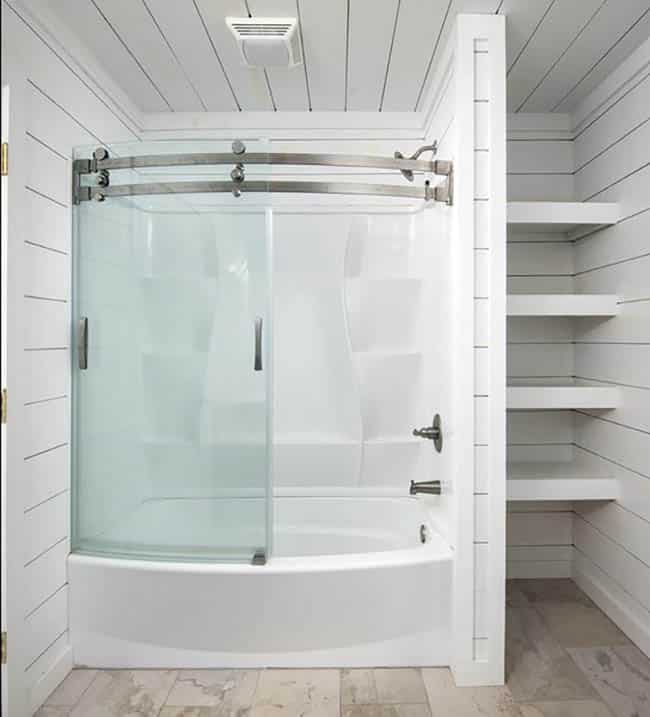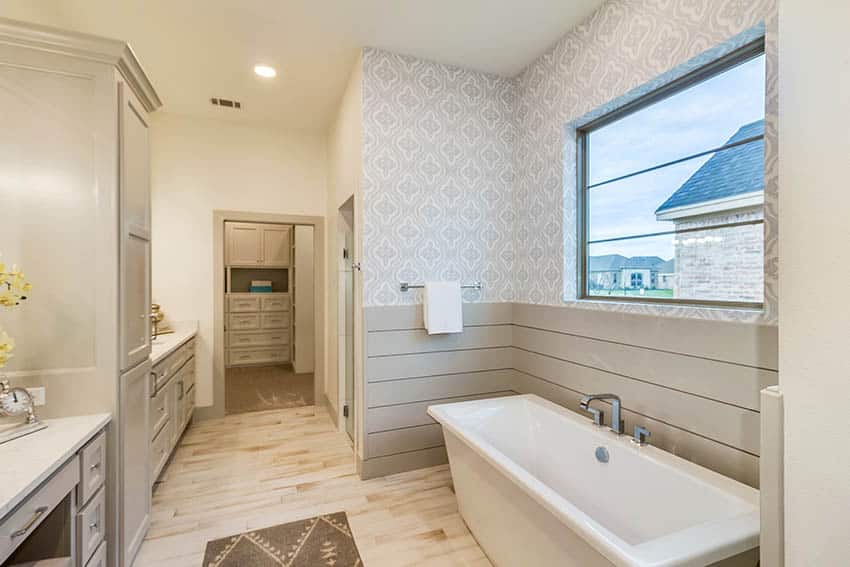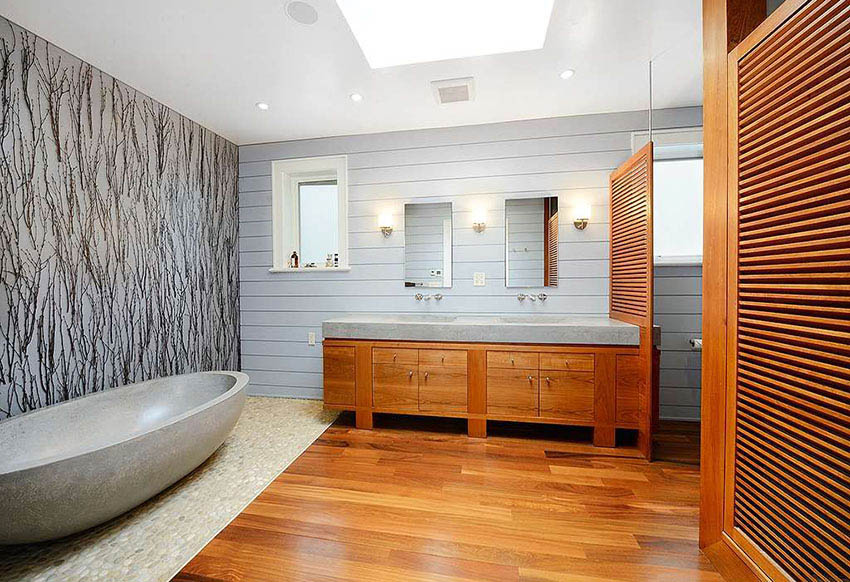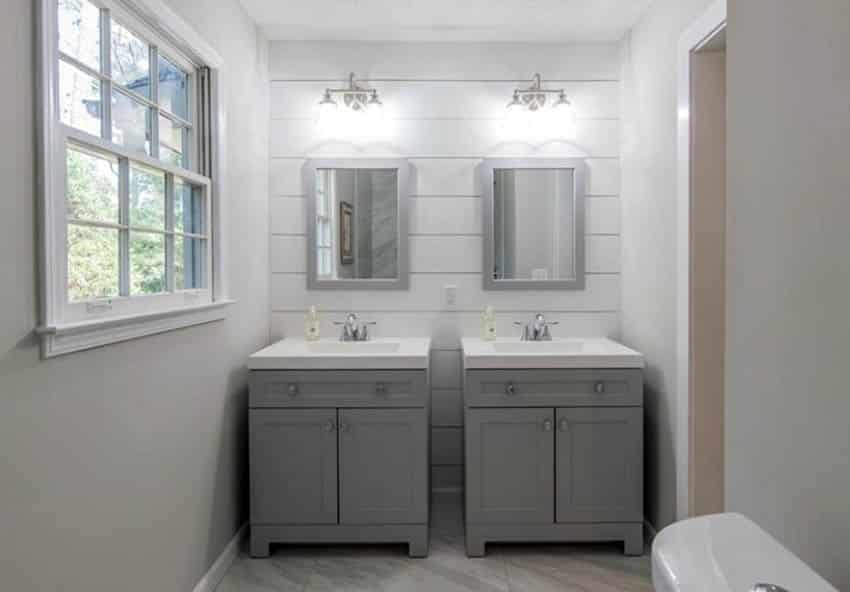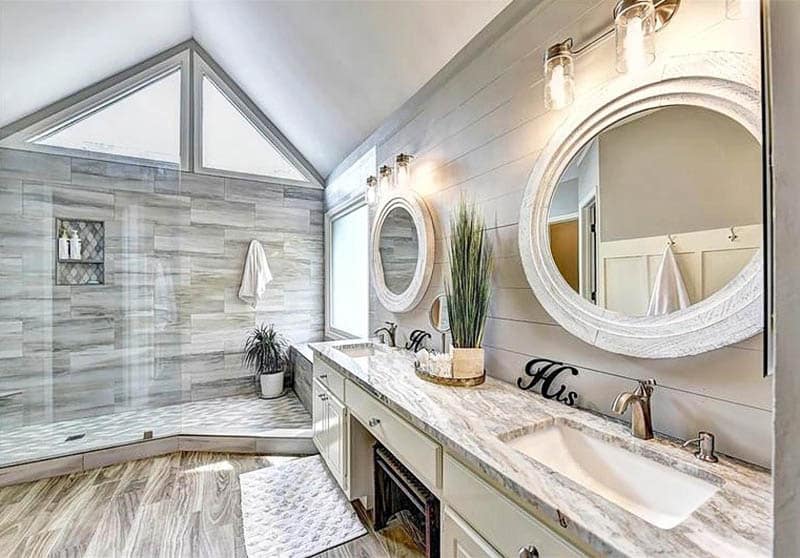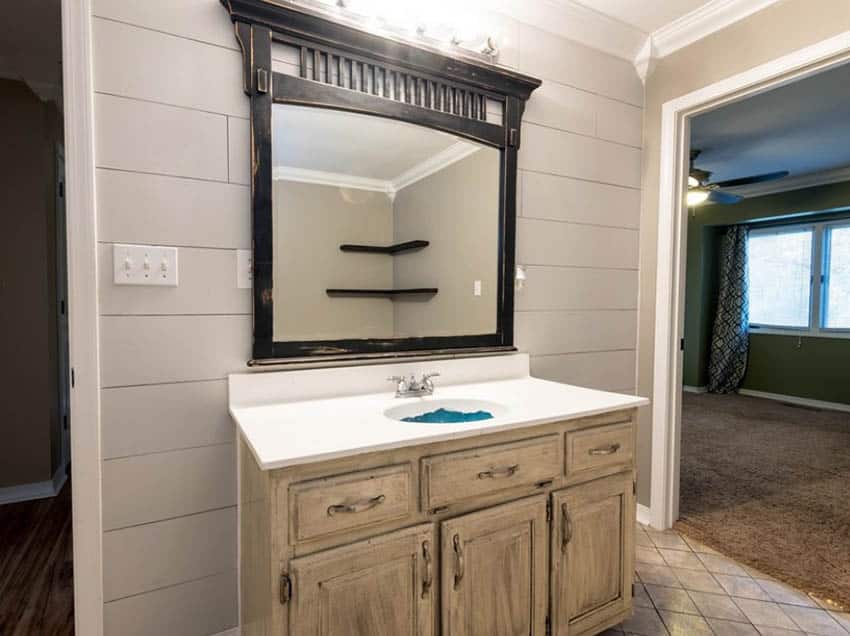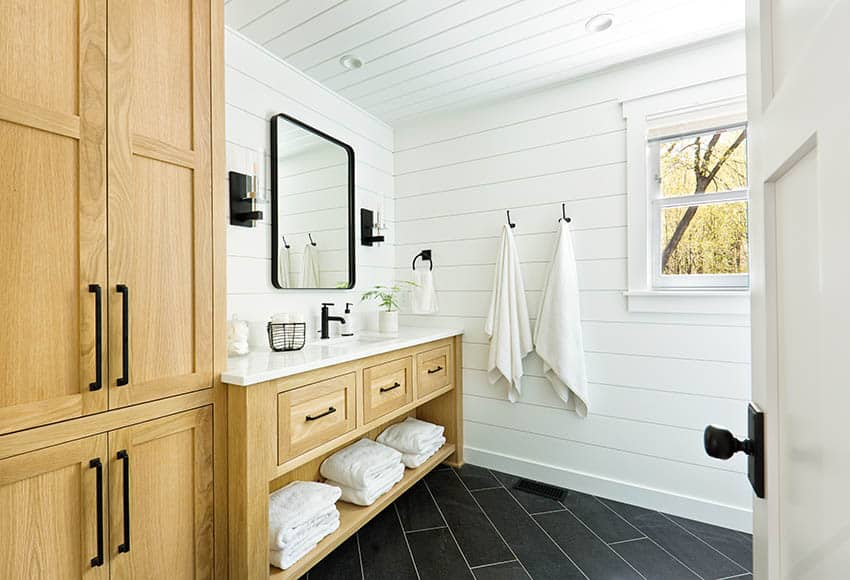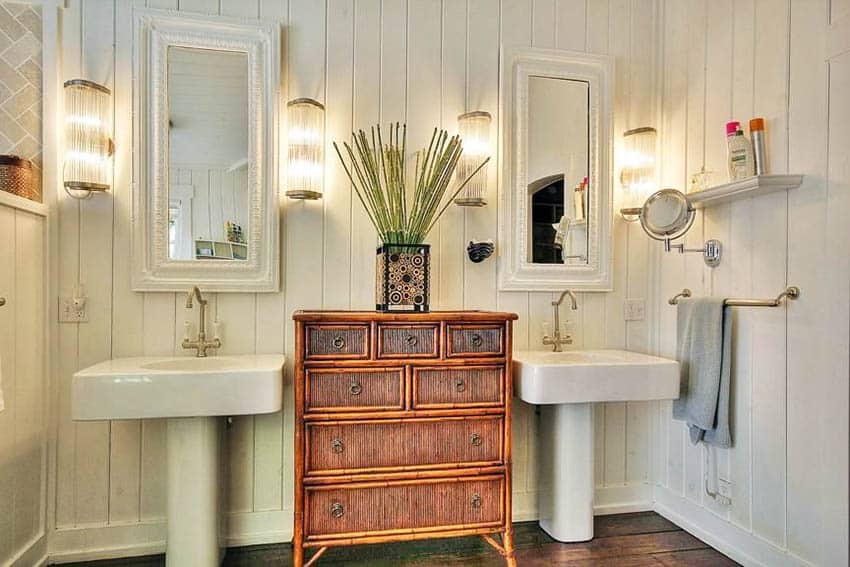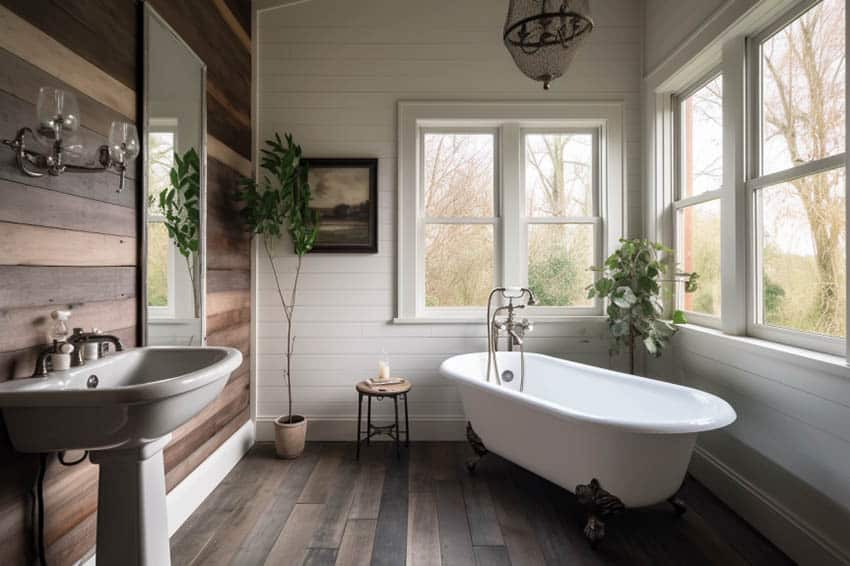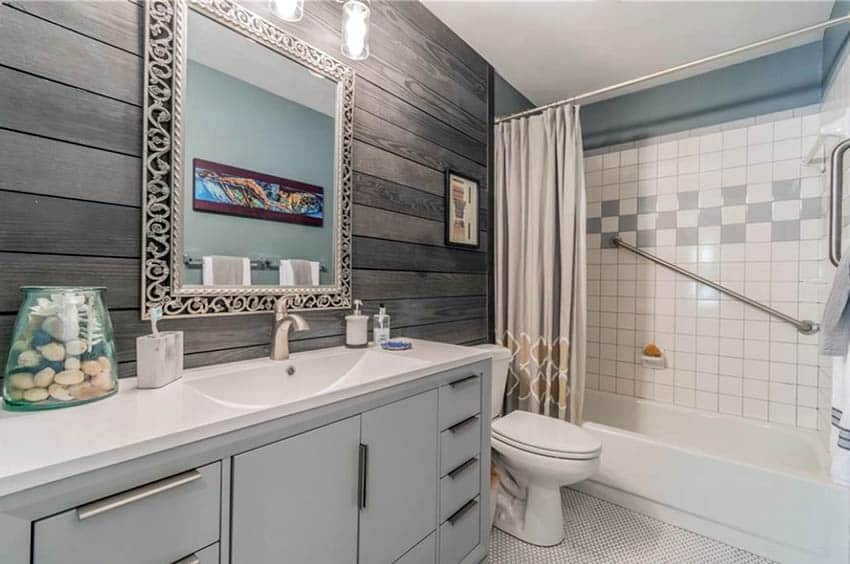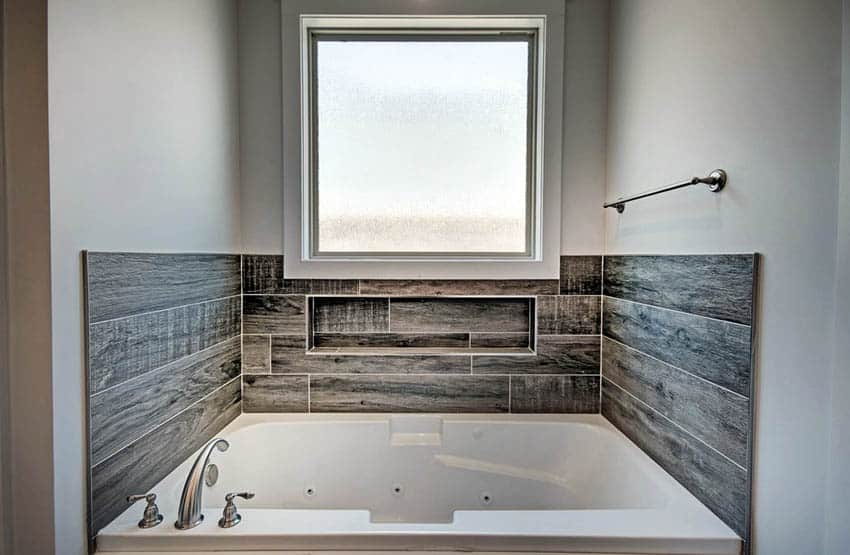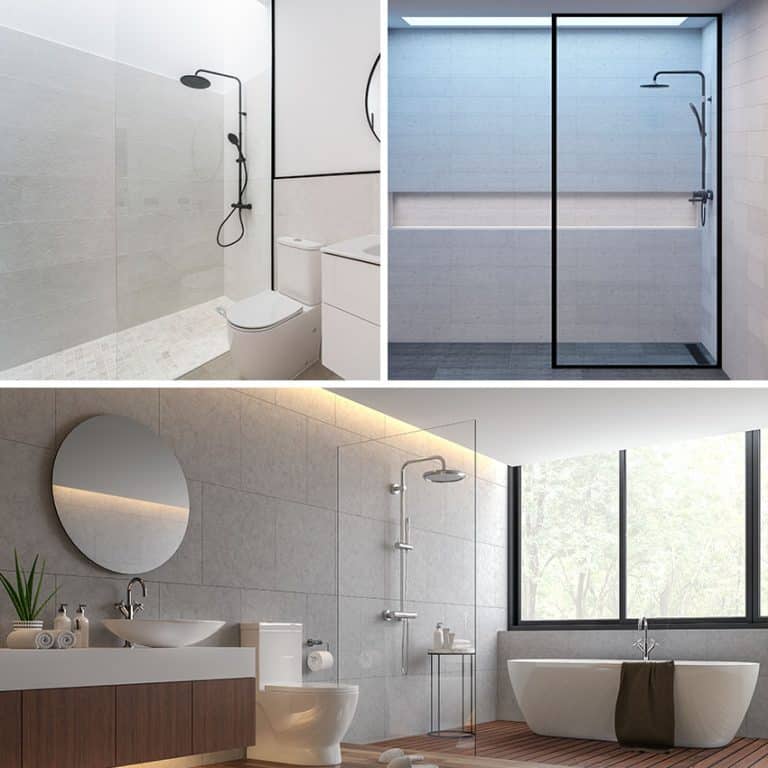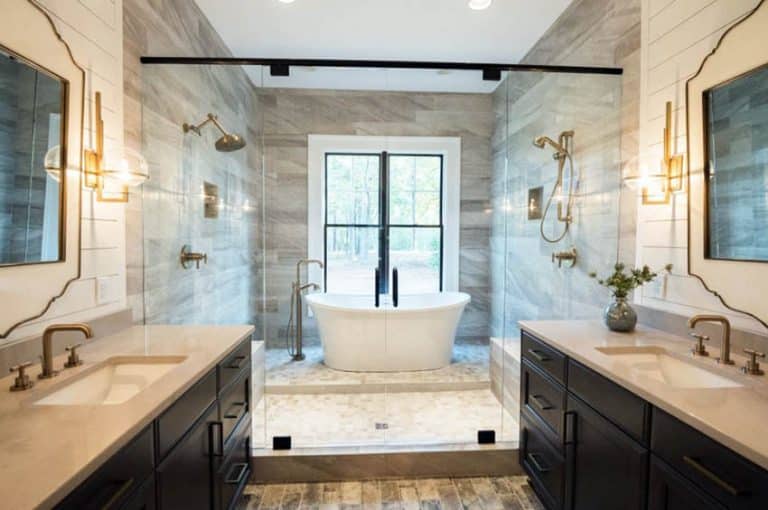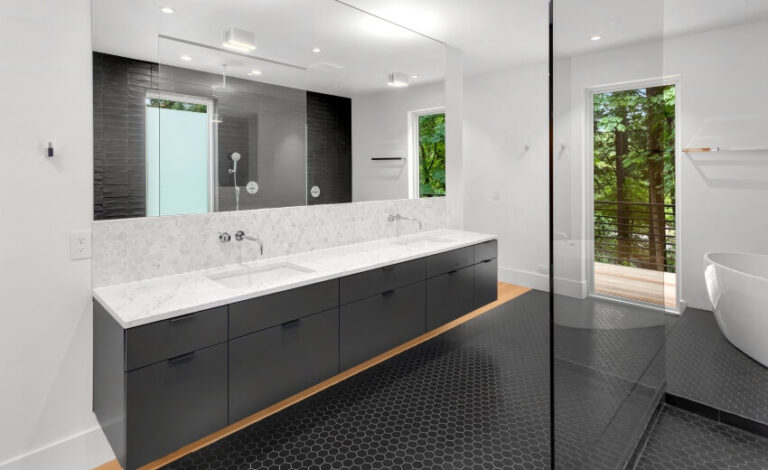29 Beautiful Shiplap Bathroom Ideas (Walls & Ceiling)
Traditionally used for constructing sheds and barns, shiplap is known for its rabbet, creating a small groove between boards. It resembles tongue and groove boards but has a tighter, overlapping fit. Because of its rustic charm and subtle texture, it has also gained popularity for decorative and aesthetic uses. It can often be seen in different applications, from kitchens, living rooms, dining rooms, and bathroom ideas.

This country-style bathroom in the picture above definitely gets a boost of that country looks with the help of shiplap boards on its walls. The white, wide boards help make the space feel bigger yet remain very subtle, letting other accent features of the bathroom remain focal points.
This beautiful craftsman bathroom design features his and hers matching vanities with shiplap walls. Wood look porcelain tile in the shower aand tub area provide a rustic design while providing protection from moisture.
Shiplap Bathroom Designs
Incorporating shiplap into bathroom designs has become increasingly popular for providing texture and visual interest.
Here are some bathroom paneling designs to consider:
Traditional Shiplap Walls – Popular design feature with horizontal wooden planks with gaps between each board.
Shiplap Accent Walls – Installing these panels on a single wall for a design feature. (Examples – behind the tub or vanity)
Painted Shiplap – Use color to enhance your bathroom’s design style. You can go bold or subtle, depending on your desire.
White Shiplap – A classic finish that offers a bright, modern farmhouse style.
Stained Shiplap – This natural wood finish offers a warm rustic feel.
Shiplap Ceiling – Adds an interesting visual element to the ceiling.
Contrasting Shiplap – Use two types of materials to create visual interest. (Example pairing tile on half & wall panels on half)
This modern farmhouse master bathroom design features white shiplap walls that provide a bright backdrop for the nautical navy blue vanity with double sinks and gold hardware.
Shiplap Accent Wall
For those with a more limited budget or a bit of a space constraint, if you just like the overall farmhouse aesthetic tongue and groove plank walls give, it would be a nice idea to use it on an accent wall in your bathroom.
Choose a wall that is visible or a wall that you want to be a focal point – keeping in mind not to choose a surface that is going to be constantly wet.
Some common accent walls in the bathroom would be behind the water closet or the vanity sink. Some also install their boards on the wall beside the shower area. (make sure it’s not in the shower enclosure!), The horizontal grooves make a nice modular guide on where to install towel racks or shelves.
This retro-style bathroom looks stylish with its combination of patterns and textures – from the hexagonal mosaic floor tiles, the subway tiles on the shower area, and the white shiplap board on the vanity/water closet wall.
The bold combination of different patterns uses varying pattern sizes, creating a mixture that doesn’t clash but complements each other.
A shiplap accent wall behind the bathtub helps provide a traditional design feel to the space.
This bathroom uses a horizontal gray painted board and battern behind its dual vanity to present an attractive accent wall.
This lovely guest bathroom features a stained wood shiplap accent wall that is complimented by light color wallpaper and a white quartz vanity top with modern cabinet doors and a stone sink.
Creative Shiplap Colors For Accent Walls
Bold and Saturated Tones – Red or orange hues for a feature wall. An expressive color against the neutrals gives the room a new dimension.
Paint a section in an expansive shiplap wall to create a backdrop for a statement piece, furniture, or a gallery of pictures.
Powerful Colors with Jewel Tones – Viva magenta, the color of the year for a renewed space. A surprising palette, such as a passionate magenta on a traditional paneled wall, can energize a space.
Add jewel-toned accents or pair them with gold or silver-colored hardware for a more opulent look. A great option for shiplap walls in powder rooms or bathrooms.
Deep and Earthy Violets – The perfect alternative for black and charcoal hues. Aside from the trendy psychedelic violets, earthy violets such as the forgotten paint color violet iron oxide can give that deep yet cozy look to a bedroom space.
Violet iron oxide is one of the oldest pigments derived from the violet hematite grounded from an iron-rich mineral.
Painted Shiplap
A painted shiplap is made up of wooden boards typically painted in a solid color. Painted wood panels or tongue and groove boards are often used in coastal or farmhouse-style homes but can work well in any design style, depending on the color and finish.
If you’re choosing colors for painted wall panels in your bathroom, there are various options to suit your preferred aesthetic and mood. Here are some popular choices:
White: This classic and timeless color creates a clean and bright space, making the bathroom feel more spacious. Additionally, white allows other elements in the bathroom, such as fixtures and accessories, to stand out.
Light gray: This neutral color complements other colors and materials well. It can create a sophisticated and modern look in a bathroom while complementing both cool and warm-toned fixtures and accessories.
Dark gray: A dark gray color can give a modern flair to a bathroom design, provided it’s not dark and offset by lighter color choices in other parts of the bathroom. When paired with white tiles, plenty of natural light, and adequate light fixtures, you can help prevent the dark elements from being too overwhelming.
Soft blue: A calming color that evokes tranquility and serenity. Soft blue can be an excellent choice for bathrooms where relaxation is key.
Pale green: A fresh and natural color that brings a touch of the outdoors into the bathroom. Pale green can create a spa-like atmosphere and pairs perfectly with natural materials like wood and stone.
Nautical blue: If you want a coastal-inspired look, a deep blue can look timeless and create a relaxing oasis feel. Nautical blue shades pair well with white finishes and tiles.
If you’re going for a nautical look, why not paint your lap boards blue? Paired with white tiles and cabinetry, you’d easily pull off that coastal vibe!
Give your bathroom a bolder look by painting your shiplap wall boards in dark gray instead of white. These especially look good when paired with white ceramic tiles, such as the subway tiles used in this bathroom design.
Here are some more creative styles of painted shiplap for the bathroom interior.
Weathered Coastal Hues – Use natural wood tones to create a backdrop for a beach-themed wall. Create alternating hues of the coastal setting with a weathered finish or dry brushed.
Color sequence: light gray, dark gray, whitewashed green, golden brown, blue-green, warm gray, brown.
Earthy Blushes – Dusty pink and terracotta tones for a full plank wall. An elevated, muted tone gives your usual neutrals a tinge of softness and warmth.
The earthy tones, such as dusty pink or terracotta tones, can emphasize your paneling installation without overwhelming the space. It’s a versatile hue that works both for modern and traditional-styled interiors.
White Shiplap
The most popular finish choice for shiplap boards would probably be white – it’s versatile, easy to match, and very much timeless.
Painting your boards white allows you to have that rustic aesthetic & subtle texture while still maintaining a more subtle appeal that allows other features of your interiors to shine.
White wooden boards were used on this country-style bathroom vanity area, complementing the shaker-style vanity cabinets.
The horizontal shiplap boards ran from the backsplash to the ceiling, and the side edge was lined with a wooden trip to help seal the edges. It’s generally advisable to paint bathroom ceiling ideas in a lighter color to keep the room from feeling too dark.
Adding lap siding boards on the walls of this freestanding bathtub helps make it stand out more in a style that matches the aesthetic of the freestanding bathtub.
These white plank paneling boards add depth and texture to this small corner vanity and wardrobe. See more white bathroom designs here.
Another way to install shiplap boards is to place them vertically. These wooden boards were positioned in wainscoting that was installed above the baseboard and topped with molding to seal off its edges.
Using white weather-treated boards for your walls in your all-white bathroom helps add more texture and depth to your bathroom.
If you feel that plain whitewalls or tiles look and feel too sterile, then using this board style will give a more rustic feel to your bathroom shower area.
Stained Shiplap
A stained shiplap enhances the natural wood finish and color and can protect the wood while still promoting its beauty. There are various ways to stain these wood boards for a stylish-looking bathroom design.
Whitewash – Whitewash stain creates a soft, subtle look that offers an airy look. The stain is achieved by diluting white paint or white stain, which creates a milky and semi-transparent look to the wall. Whitewashed finishes are suitable for beachy, coastal, or Scandinavian interiors.
Graywash – An alternative to your whitewashed stain, the cool grayish hue accommodates modern interiors while still showcasing wood grain, which usually has white graining, enhancing the texturized look.
Ebony and Jacobean Stains – The dark wood stains are the go-to colors to add a strong contrast against a white backdrop. This emphasizes the graining of a natural wood installation.
Weathered – A weathered or distressed stain can give planks a rustic and vintage feel. This look is achieved by combining stains and sanding the wood to create a textured, worn effect. The worn-out look is perfect for farmhouse or industrial-inspired interiors.
Walnut Stains – When staining oak, maple, cherry, pine, or fir, a walnut stain can enhance the wood’s natural grain with a uniform coloring. Walnut stain colors range from light golden brown to a deep, almost black-brown.
Golden Oak Stain. The golden oak stain has just the right amount of yellow and brown combination, creating a warm and inviting quality. The golden oak allows the natural graining to show off, while the stain blends well with neutral and deep blacks.
Natural or Clear Stain. When aiming to showcase a wood wall’s natural color and graining, a clear and natural stain is a great option, as it enhances the surface while giving it a polished look. Clear finishes usually have that glossy quality, but matte finishes are also available.
Contrasting Shiplap
A contrasting shiplap combines a half wall of grey with a half wall of patterned wallpaper to provide an interesting contrast and depth of detail.
Wallpaper and Horizontal Shiplap Install – Spruce up a powder room with a wallpaper pattern and a horizontal shiplap. With the wide range of patterns available, that perfect design accommodates one’s taste.
Combine the Heavy Patterns With White Painted Horizontal Planks – Choose the upper third or half of the wall for the wallpaper and the rest with the horizontal panel design. Waterproof wallpaper is available for bathrooms and kitchens.
Subway Tiles and a Vertical Shiplap Install – The classic white subway tiles and a white vertical shiplap showcase the textures.
Hexagon Tiles and a Vertical Slat Panel Placement– Install the lower half of the wall with a vertical panel design and the upper half with hexagon tiles or glass-shaped hexagon mosaics.
White Straight Stacked Tiles and Vertical Board Position. Surround the third upper wall with a vertical paneling stained in red cedar or any rich, warm wood stain. The lower half of the wall is installed with fresh white tiles straight stacked. Use 100 mm x 300 mm white tiles.
DIY Shiplap Walls
For those who like the look, there are many different DIY guides available online that might match your project needs and application area.
Popular materials used as shiplap boards are solid wood, plywood, and MDF (for applications in areas without much moisture). The material used is determined depending on the area of application.
If you expect constant water/moisture exposure (such as shower walls) and you’re not very confident with the efficiency of your ventilation, then it would be a good idea to skip on the wood and plywood (which both tend to warp when exposed to too much moisture) and use more resistant alternatives such as PVC.
This modern bathroom design features abundant natural materials with teak wood, travertine tub, and river rock flooring. The gray shiplap wall contrasts the vertical tree limb accent wall design.
If you’re using the boards in areas outside the shower, it will still be prudent to check on your waterproofing and use weather-resistant boards (like marine plywood) to avoid moisture warping.
A good tip for bathroom shiplap DIY is to prime and paint your boards before installation, as it will be difficult to cover every edge, nook, and cranny of your boards once installed.
Ensure all holes are sealed properly, and allow your paint to cure for at least 24 hours to ensure no moisture seeps through your paint.
This half bath uses tongue and groove boards on its accent wall behind the vanity area. The horizontal boards help make small bathrooms look wider and also is a good marker to align the mirrors and other wall installations.
This master bathroom has a greige painted shiplap wall above his and her dual vanity with a granite top.
Instead of completely parallel boards, this bathroom accent wall alternates the overlap of its shiplap boards and paints it gray to match the wall paint.
Shiplap Ceiling
Shiplap ceiling design can vary depending on the desired aesthetic and functionality of the space.
Here are some specific details that can be incorporated into a ceiling plank design:
Board orientation: Shiplap boards can be installed in a horizontal or vertical orientation, with each creating a different look and feel. Horizontal boards have the effect of making a room feel wider, while vertical boards can add height and make the room feel taller.
Board spacing: You can achieve different looks by the amount of spacing you have between boards. A tighter spacing creates a more traditional or farmhouse-style style, and a wider spacing creates a more modern style.
Color and finish: These boards come in various wood species and finishes, including natural wood, painted, or stained. The color and finish chosen will depend on the desired style of the room.
Trim details: Adding trim pieces around the edges of the ceiling or between board seams can enhance the design and add dimension to the space.
Lighting fixtures: Positioning lighting fixtures in your ceiling board design can create focal points and highlight specific areas of the room.
Here are a few different styles to consider for your shiplap ceiling:
Classic White Shiplap – White is a forever favorite planking and a safe and versatile choice for ceilings due to its clean look and ability to brighten a space.
Indigo/Gray Wash Shiplap Ceiling Band – For high ceilings, an indigo-washed paneled ceiling that continues around ¼ or 1/3 (depending on the ceiling height) of a wall.
Two-toned Shiplap – For a unique and eye-catching look, consider using two different shiplap colors on your ceiling, creating a playful and dynamic effect.
- Black and White – Contemporary, Transitional, Mid-century
- Yellow and White – Contemporary, Art-Deco, Transitional
Shiplap Design Materials
Here are the most popular shiplap materials for a moisture-prone environment, such as the bathroom.
Natural Wood Shiplap – Wood is a popular choice for these bathroom planks because of its natural warmth and beauty. The organic material can be stained or painted to match any design style and can be made from various species, such as pine, cedar, or oak.
Cedar is one of the best types of wood for shiplap because it is more resistant to Moisture and warping than other types of wood.
It’s also one of the more beautiful materials, and many people seal it with a clear coat to keep the natural look
• Redwood.
• Teak.
To ensure longevity with any type of wood, use waterproofing sealants and follow the manufacturer’s instructions for maximum waterproofing protection for your wood panels.
• Polyurethane – When opting to showcase the wood graining, a clear polyurethane can be applied on the surface. The polyurethane finish on a shiplap will provide an added layer of protection and help fill in any hidden gaps.
Two types: Oil-based and Water-based
Oil-based polyurethane is made from natural oils and solvents and is more durable than water-based polyurethane. However, oil-based polyurethane has a strong odor and takes longer to dry than water-based polyurethane.
On the other hand, water-based polyurethane is made from synthetic resins and water and is a popular choice for those sensitive to the strong odors of oil-based polyurethane. Water-based polyurethane dries faster than oil-based polyurethane but may not be as durable.
• Epoxy – Epoxy on wood is a popular way to create a durable and long-lasting finish that protects the wood from dents, stains, and water damage. Epoxy is a type of resin that is applied to the surface of the wood and then hardens to create a thick, protective layer.
• Marine Varnish – Produced from a combination of oils, resins, and solvents that penetrate the wood and create a hard, protective layer on the surface.
The varnish is designed to be flexible and expand and contract with temperature change and humidity, which is important for wood, especially in a bathroom where humidity and temperature changes occur.
Tip: To ensure that the primer and paint have seeped through the whole wood plank, it is recommended to paint the wood before the installation process. Allow the paint to cure for one day to ensure no gaps would allow water to seep through the wooden openings.
This cozy cottage bathroom provides full vertical shiplap walls with dual mirrors and two matching pedestal sinks.
PVC Shiplap – Water-resistant and low-maintenance PVC is an ideal material for bathrooms. The impervious surface means it’s easy to wipe off dirt and remove soap scum, thus won’t harbor the growth of mold or mildew. Moreover, insects won’t be able to penetrate the non-porous surface.
Unlike wood, PVC or polyvinyl chloride wall panels will not warp or rot, making it a durable material as a bathroom finish. Any PVC cladding can last as long as 50 years with a quality-made product. However, an average of 20 years is the expected life service of PVC shiplap in a bathroom setting.
A great advantage of PVC is its versatility yet durable material that can be installed in trickier corners or angles in a bathroom. Using the usual woodworking tools, a knowledgeable DIYer can update a bathroom interior with PVC panels.
There is a wide range of colors and styles to choose from when it comes to synthetic materials that can even simulate the look of organic textures such as wood.
However, PVC panels that mimic wood can still be manufactured to look and texture, so it’s best to ask for suppliers’ samples before specifying the product in a newly built or renovation project.
UPVC – A stronger version of PVC but without the plastic content, uPVC or unplasticized polyvinyl chloride is a great option for a shiplap bathroom.
The absence of phthalates and BPA content means it doesn’t give off harmful fumes; it is also fire-resistant, durable, and recyclable.
UPVC shiplap, though, is rigid in form and not flexible like PVC, which can be a downside when installing bathrooms with complicated layouts.
But, overall, UPVC panels should be included in the list of choices for a bathroom shiplap, especially for owners with a bigger budget, as UPVC costs more than PVC.
MDF – An ideal material for bathroom shiplap installation that is water-resistant, like PVC and UPVC, but with a relatively lower price.
An MDF with an MR or moisture-resistant property is recommended, as it is infused with resins that prevent that material from absorbing water. An MDF shiplap has been around as a building material with many colors and designs available.
Composite – These panels are made from a mixture of wood fibers and plastic and are designed to mimic the look of real wood while being resistant to moisture, mold, and rot. They are also available in various colors and finishes and can be installed with a similar tongue and groove system.
Tile Shiplap – Whether made from porcelain or ceramic, tile these materials have various designs. Highly durable and resistant to moisture, tile shiplap is great for wall installation in various rooms. These farmhouse-style tiles are also easy to clean and maintain, as they can be wiped down with a damp cloth or mop.
Will Shiplap in a Bathroom Be Affected by Moisture?
The simple answer to this is yes. This, however, is highly dependent on many factors, such as:
- Material – if you’re using PVC, moisture isn’t a problem.
- Ventilation – this also affects how your boards will be able to hold up against moisture exposure. A well-ventilated bathroom won’t have many problems with warping or molds on their shiplap walls.
- Seal & Finish – if you ensure your material has been properly filled, sanded, finished, and sealed, there shouldn’t be many problems with moisture. Choose a durable paint finish, such as a marine-grade acrylic enamel, to make sure it will hold up against moisture!
This modern bathroom uses PVC decking boards on its walls behind the toilet and vanity instead of wood or plywood.
PVC decks can mimic the color and texture of real wood (they have a variety of wood colors to choose from) but are resistant to moisture and do not warp like wood or plywood.
How to Protect Shiplap
Ensuring a proper finish and sealing of your shiplap will help prolong and protect it. If you don’t fill and seal your materials properly, any effort to keep them dry won’t protect them from mold build-up or warping, so make sure you get it right from installation.
The minimum protection should be using primer and semigloss paint to cover the wood. However, for added protection against moisture, it’s advisable to use a marine-grade polyurethane.
If you’re just in for the look of shiplap walls, another great and easy-to-maintain option would be to use ceramic tiles that mimic the look of wood. This allows you to get the look with more peace of mind!
For more related shiplap ideas, check out our gallery of shiplap dining room ideas here.


